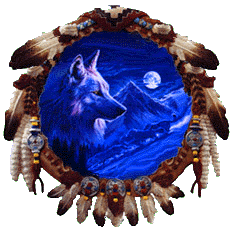Welcome to my
indian page.
I hope you enjoy your visit.
There is
a little bit of Cherokee blood
in my family so I figured I would do a page on the
Cherokee Indians. Unfortunately I only got about 5% of
that blood.
I have always loved indian stuff, I have visited an
indian reservation in
the state of Virginia, I thought it was really cool. But
I am sorry to say that
I forget where exactly it was. But I will try to find out
so that I can add it to this page.

This is the official Cherokee Flag
If you
would like to learn more about th flag, the language and
their clothing
please visit this site:
Official Site
The Cherokee Indians, a branch of the Iroquois nation, can trace their history in North Carolina back more than a thousand years. Originally their society was based on hunting, trading, and agriculture. By the time European explorers and traders arrived, Cherokee lands covered a large part of what is now the southeastern United States.
The
Cherokee lived in small communities, usually located in
fertile river bottoms. Homes were wooden frames covered
with woven vines and saplings plastered with mud. These
were replaced in later years with log structures. Each
village had a council house where ceremonies and tribal
meetings were held. The council house was seven-sided to
represent the seven clans of the Cherokee: Bird, Paint,
Deer, Wolf, Blue, Long Hair, and Wild Potato. Each tribe
elected two chiefs -- a Peace Chief who counseled during
peaceful times and a War Chief who made decisions during
times of war. However, the Chiefs did not rule
absolutely. Decision making was a more democratic
process, with tribal members having the
opportunity to voice concerns.
Unfortunately, the Cherokees did not enjoy prosperous times for long. Gold was discovered on Indian lands in Georgia. Political pressure was exerted by President Andrew Jackson to confiscate Indian lands and remove the Cherokees to the West. Numerous injustices against the Cherokee Nation culminated in the signing of the Treaty of New Echota. Those who signed the treaty did not have the authority to represent the entire Cherokee Nation. Nevertheless, the treaty stood. The Cherokees were taken from their homes, held in stockades, and forced to move to Oklahoma and Arkansas. Almost 14,000 Cherokees began the trek westward in October of 1838. More than 4,000 died from cold, hunger, and disease during the six-month journey that came to be known as the "Trail of Tears."

Language
The preservation and perpetuation of language
is one of the most important aspects of cultural
survival. The
Cherokee language is spoken today by some 10,000
Cherokees who
reside in northeastern Oklahoma and by at least 1,000
Cherokees living
in the vicinity of Cherokee, North Carolina. Cherokee is
related to the
Northern Iroquoian language, which includes Mohawk,
Onondaga, Oneida and Seneca-Cayuga.
Many Cherokees speak their ancestral language
in their homes, at churches and at Cherokee stomp
grounds.
More than 150 years after the Trail of Tears, Cherokee
remains
one of the most widely spoken Native American languages.
To ensure
the preservation of the Cherokee language and culture,
the Cherokee Nation
supports and provides numerous bilingual education
programs.
Here are some
other indian links that you might want to check out:
A.I.M.
Other
Cherokee Nation of Oklahoma
Cherokee
Publications
Sequoyah
Birthplace Museum
National Native
American Tourism Conference
Cherokee
Jewelry
Cherokee Images
The
Cherokee Tribe
Cherokee
Indians
Cherokee
Winds
Cherokee
History
Indian Tatoo/Ink
Events
Click here to
return to main page:
